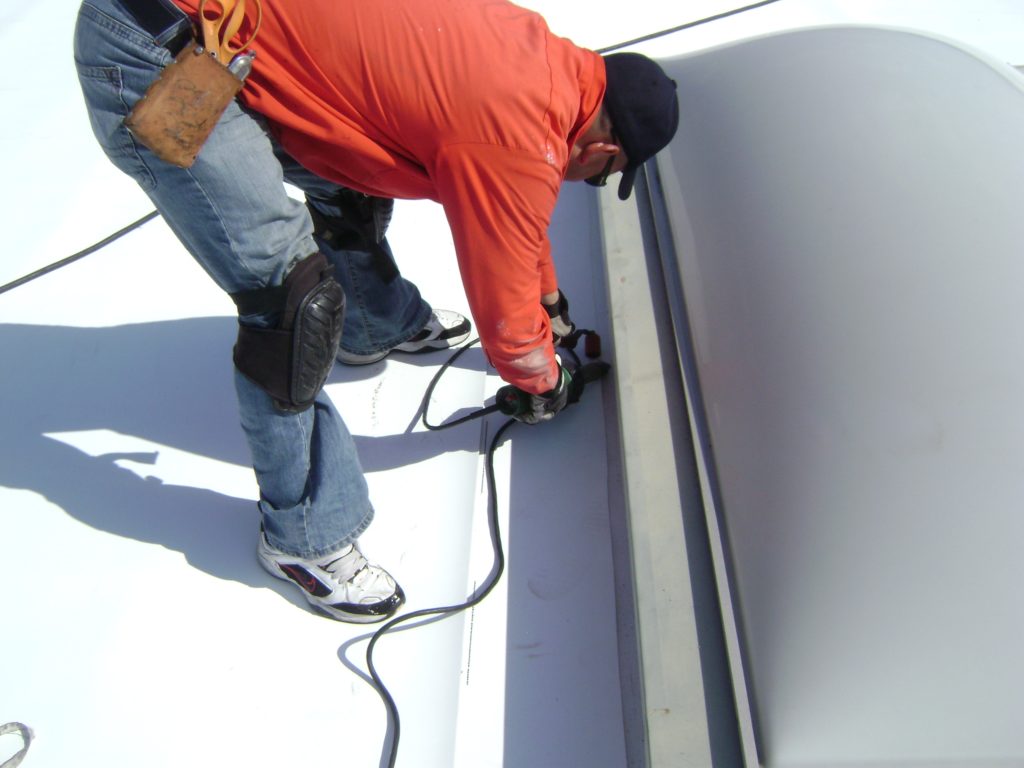SOUTHERN CALIFORNIA WINTER MAINTENANCE TIPS FOR COMMERCIAL & INDUSTRIAL ROOFING SYSTEMS
Your Los Angeles County, California or surrounding commercial building’s roof is exposed to all manner of environmental exposure and weather conditions, making it vitally important to stay current with yearly commercial roof winter maintenance and repairs.
Some weather events including, wind, heavy rain, sleet, hail, extreme hot or cold, and even some mild weather conditions can wear your roof down over time and can even cause serious damage to California commercial and industrial roofs.
While severe weather is rare in Southern California, taking extra precautions to protect your roof during the colder winter months is an important step to take to secure your property and protect your investment for the long term.
Now that we’re officially into Fall and heading towards Winter, it’s a good time to think about implementing a commercial roofing winter “preventative maintenance program” to preserve and extend the life of your roofing system so that whatever Mother Nature has in store, your roof will be protected from the elements.
Stone Roofing Company’s expert roofing specialists recommend the following maintenance tips for getting your commercial roof ready for Winter:
LOS ANGELES COMMERCIAL ROOFING
Get Your Los Angeles or Southern California Commercial Roof Ready for the Elements with a Preventative Winter Roof Maintenance Inspection
As commercial roof repairs will likely be more expensive after the colder months and you may even need to fully replace your roof if any damage is left unrepaired, addressing any pre-existing roof damage needs to be taken care of right away.
To ensure that your commercial roof is in solid condition to get through the winter months and to avoid full roof replacement, it is always best to work with a licensed, professional commercial roofing contractor. A professional roofing contractor will assess the condition of your roof, identify weaknesses or damage to your roof, and will help you restore it to optimal condition with quality materials.
During your commercial roof winter maintenance assessment, the following items are recommended:
Check Drainage for Ponding
The flat roofing typically found on commercial buildings naturally gets damaged more frequently than pitched roofing and if not corrected, further damage can occur as the weather gets colder. Protect the value of your building by making sure that water is properly draining from your roof and that all drains, gutters and downspouts are checked.
Inspect for Damage, Cracking & Tearing
Heavy rain, sleet and hail are all capable of damaging your roof and the damage can be worse if your roof has any existing cracks or tears. To prevent weather related damage, be sure to find and fix any issues before the bad weather arrives.
Check Flashings, Metal Detailing, HVAC and other projections
All flashings need to be inspected and verified that they are secure and sealed so water won’t accumulate under them and potentially freeze in colder temperatures. Inspect all metal details and make sure they are secure and properly installed. HVAC & other Projections – Verify that there has not been any alterations made to any penetrations. If there has, ensure all are flashed and properly sealed.
Touch Up Exposed Caulking Roof sealants not only cover roof leaks, but they also provide a protective layer to prevent water and sunlight penetration. These sealants come in many forms, including liquid in a paint can, liquid in a spray can, liquid in a caulk gun, and adhesive tape.
Pay Attention to Prevent Pitch Pocket Failures
Used on both sloped and flat roofs, pitch pockets provide a water-tight seal around columns or other roof penetrations. Problems with pitch pockets, a type of roof flashing used to seal penetrations, prevail on all types of roofs but are most typical on built-up or modified bitumen roofing systems. There are many reasons a pitch pocket fails. The sealer can dry out and shrink. Structural movement may also be to blame. If the penetration that is wrapped by the pitch pocket moves or vibrates, the pitch pocket seal could be compromised. Premature failure may be due to improper installation (e.g. incompatible materials) or lack of maintenance.
Regardless of the cause, all pitch pocket problems mean leaks. Routine inspections and basic maintenance (e.g. refilling the sealer) are the best course of action to keep pitch pockets in working order.
PRO TIP: If your roof has a high volume of penetrations, have it inspected quarterly.
Safety, First!
Now is the time to review your roof maintenance protocols to get in front of any safety concerns prior to the colder winter months. Some of those protocols include checking walk pads, rail hatch systems and snow guards.
Ask for Written Report for Recommendations
After any commercial roof inspection, make sure you receive a full written report along with photos and fully understand any recommended repairs. The overall goal of the inspection is to uncover any potential issues or concerns or damage to ensure your roof is in good condition and will remain that way throughout the changing seasons.
Hire a Licensed, Trusted, Reputable Southern California Commercial Roofing Company to Perform Necessary Repairs
If you have hired a reputable, experienced Los Angeles Commercial Roofing Company to perform your preventative maintenance check-up, they will be able to offer a quote for any needed repairs. That’s why it’s really important to find a Certified, licensed California roofing company that has the experience and expertise to tackle your roofing system. Don’t be afraid to ask questions and review the photos with your contractor.
PRO TIP: Los Angeles County, California Roofing Contractors at Stone Roofing Company recommend periodic inspections—either quarterly, semi-annually (fall and spring are the best time for this), or annually.
Clean & Clear Debris, Leaves, & Twigs
Now’s the time to trim those trees, clear roof debris, and leaves and twigs. Did you know that leaves can destroy your Southern California flat roof? Leaves on a rooftop surface retain moisture and will most likely cause rot. As leaves fall and the wind whips everything around, leaves and debris end up in roof corners and as moisture gets trapped within the leaves piled on the flat roof, it starts to break down and decompose on your roof surface. While there may not be frost on the ground there is likely to be frost on your flat roof. As the sun warms the surface more decomposition of the roof debris happens. This can create organic growth on your roof’s surface, which can lead to premature deterioration to your flat roof surface.
PRO TIP: Roof Cleaning Extends the Lifespan of Your Roof.
Plan and Prepare for Severe Weather Conditions & Rain
Routine maintenance is an essential component of any long-term plan for maintaining the health of your commercial roof. Find a licensed, experienced commercial roofing repair contractor you can trust, and get in the habit of scheduling bi-annual roof inspections to extend the life of your roof, protect your valuable property investment, conserve energy, save money, and avoid even bigger, more expensive issues in the future!
Roof Repair Near Me
Are you ready to schedule your Commercial Roof Inspection? Stone Roofing Company is here for you!
At Stone Roofing, we have over 80 years’ experience working with a wide variety of roofing systems and materials so no matter what we find during inspection, we will guarantee to repair your roof to optimal standards so it is ready for winter weather.
For more information on Los Angeles County, Orange County & Southern California commercial roof inspections, contact Stone Roofing Company. Our inspections are always free!



